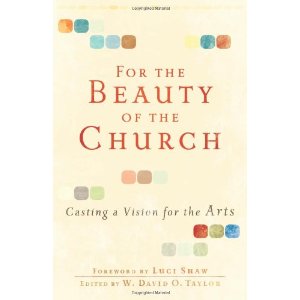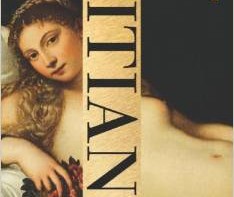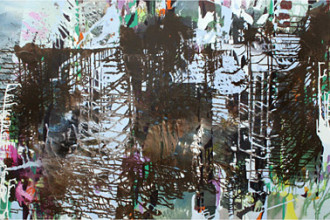In chapter 5 of For the Beauty of the Church, Barbara Nicolosi seeks to offer a look inside the mind of the artist, their concerns and troubles and to help the rest of us to identify the artists among us. Nicolosi seeks to define the artist’s end beyond themselves as ‘beauty’ and offers four signs to assist in the identification of the artists in our society. This chapter is written from the perspective of training and guiding artists in general and is not directly, predominantly or primarily to artists working within a church context. In fact, Nicolosi’s role with Act One – an organisation that trains Christians who want to work in the mainstream entertainment industry as writers, artists, or executives – attests to her commitment to the development of artists. Nicolosi contends early on that there two kinds of people: people who are artists and people who are supposed to support them (104). While this binary is somewhat problematic, it is reasonable to recognise that artists are set apart with creative gifts.
Dwelling in the terrain?
Nicolosi suggests four signs of an artist as a way of identifying them within our community: artistic talent shows up early, their work has emotional power, a “real artist’s work is going to have a freshness, a startling quality of something new”, and finally, one can identify an artist by their obsession with details of form. Moreover, the foremost manner for identifying artists is by their proximity to beauty: “Beauty is the terrain of real artists, and one way to recognise them is if they dwell in this terrain” (106). However, I remain confused as to what it means to find the artist in the terrain of the beautiful. What would it mean to live in the terrain of the Truthful — Does the theologian live there? And what of the land of the good, because I think I’d actually like to live there. That may all sound quite glib. But my point is this: I am still confused as to what the “terrain of the beautiful” is or means. I am not sure I understand it even as a metaphor. What beauty is and comprises of is an incredibly important question and must be teased out.
Especially in light of the fact that, for Nicolosi, the end of art is beauty. Nicolosi suggests beauty has three aspects – wholeness, harmony, radiance – while describing persuasively that it is not sentimentalism. While her delineation of beauty in this way is quite straightforward, Nicolosi also defines Art by what it is not: Art is not political, egalitarian, or a soothing distraction. In contrast, I would argue that art can be these things and still be art, I think the problem arises when it is only political, egalitarian, or a soothing distraction. Rather we should acknowledge that Art can also be these things but do not necessarily have to be.
According to Nicolosi, the role of art is to communicate the beautiful. But is that all art is or should be? What about art which makes us think? What about Truth? Does redefining beauty to always capture what art is and does profitable? Or are we always obscuring something? Art is about so much more than just beauty; rather than seeing truth and good as separate, should we not be aiming for both?
Nicolosi goes on to suggest that there is a special revelation open to the artist:
“When an artist pursues the beautiful, he or she opens a channel of revelation between God and humanity. It’s an extension of the revelation that occurs through the beauty of creation, about which St. Paul claimed, “For since the creation of the world His invisible attributes, His eternal power and divine nature, have been clearly seen, being understood through what has been made” (Romans 1:20 NASB)” (106)
This is possibly one of the most theologically problematic sections of the chapter, and my concerns are none diminished by Nicolosi’s declaration that she is neither scholar nor theologian. Do artists really have direct access to God different in kind to others? Is this akin to the muse? Different in degree I will concede, but in kind? no. And the inference of the artist as muse is a very problematic concept especially in light of Nicolosi’s use of terms like genius and beauty in this chapter.
Nicolosi’s use of terms genius and beauty and “artist as prophet” seem distinctively born out of 19th century romantic ideas. This is a conception of the artist that must be critically examined. In that context, and it seems in Nicolosi, Genius is the artistic expression born out of an unexplainable faculty of the mind. There was an unfortunate dichotomy drawn between originality and tradition. In the 19th century, tradition was a definitive sign of a lack of genius and genius was itself representative of a disconnect from tradition. I think the truth lies somewhere in between and we must acknowledge the risk of what Baudelaire describes as the “emancipated journeyman” wherein art has been ruined and lost its power. I fear that we have failed to learn from the last 70 years and as overrated as it may be, Roland Barthes should be revisted on this point. Nicholas Wolterstorff is also particularly helpful in explaining the intellectual history of these ideas in Art in Action.
Despite offering minimal protests to the contrary, Nicolosi largely presents the artist as a crazy, obsessive individualistic person unable to function in a linear society or meet their responsibilities external to their art. While, I’m sure Nicolosi would qualify, and does to a small extent, that there is no one way to “be” as an artist, it is somewhat disconcerting that so much emphasis is placed on the behavioral traits of an artist in this chapter. This limited picture is something Joshua Banner addresses in the very next chapter, which is of some amelioration (he goes so far as to say he felt he needed to specifically reject the idea of the eccentric, quirky, anti-social artist and be himself).
This chapter is a valuable contribution to the collection as a clear expression of where Nicolosi believes the artist can be found and despite my reservations I appreciate her experience and insight. I do have three questions that arose from Nicolosi’s chapter, at least for me, with a view to moving the discussion forward: What does it mean to be a creative person (artist) and be like Christ?; and How does the church and pastorate disciple artists? How do they offer helpful critique and support?
Further Reading
In addition to the books Nicolosi suggests, I’d like to suggest the following: Nicholas Wolterstorff, Art in Action; Jeremy Begbie, Voicing Creation’s Praise; and Dorothy Sayers, Mind of the Maker.







Thanks for this serious engagement with Nicolosi’s essay. As you know, I agree with you that Nicolosi’s essay draws on a concept of the artist develops at the end of the 18th century and through the 19th century. For that reason, I think its underlying assumptions need to be questioned because this concept of the artist is by no means universal. Two elements seem to emerge from your post in regards to the romantic concept of the artist: first, the artist as prophet (i.e. the framed quote), and artist as bohemian (individualistic and anti-social behaviour). Underlying these elements are certainly deeper theological assumptions about what it means to be a human being.
Now that the concept of the romantic artist is exposed as operating within Nicolosi’s essay, it is of course possible to critique and question it (as you have shown). Even though I am in agreement with what you have said, I still wonder whether or not it is possible to glean some positive value from the romantic concept of the artist; whether or not the romantic concept of the artist is correct in certain regards. So, then, one could add an additional twist to the three questions you pose at the end. How does the romantic concept of the artist make a positive contribution to the Christ-likeness of the creative person, to the discipleship of the artist, and to the critique and support of artists by the church?
Anna, great post. As you rightly observe–and Jim, you as well–this is a “difficult” chapter, to the extent that Barbara makes strong, sharp-edged statements. I’m glad the chapter belongs to this book. It represents an important perspective; it also represents a written form of a public talk that, on the night Barbara spoke at the symposium, generated inordinate amounts of positive response from the several hundred artists in the room. (The several hundred pastors hung in there for the blustery, often humorous but always unapologetically un-minced talk.)
I only have time for a quick response here. Hopefully I’ll have more time over the weekend.
First, as with all things in the book, so much of the discussion turns on the definition and application of terms. Jim, I love the question you posed at the end of your comment. That would make for a fantastic article, dissertation, book, symposium and long night of adult beverages.
Second, Murray Watts, who lives nearer to you guys than to me, gave a nice talk at the Laity Lodge a few years ago in which he explored the dual idea of artist as servant and as prophet. Again, much of the persuasiveness of his talk depended on the use of his terms. But I appreciated the way he brought both metaphors to play in the vocation of the artist.
Third, Paul Westermeyer, in his chapter on the psalms in *Te Deum: The Church and Music*, engages von Rad’s argument that, from an OT context, one should not pit the priests against the prophets. They operated together, von Rad insists, for the common well-being of Israel. Westermeyer goes on to explore this idea in relation to the church musician. He notes that the temptation has been for the church musician to see him- or herself *either* in the priestly cast or in the prophetic cast. For Westermeyer this leads only to a problematic outcome.
Lastly, while we are right, with regard to the artistic vocation, to avoid the excesses of the 19th century Romantic movement as well as the excesses of the Pragmatic movement, we must still ask ourselves what is unique in the life and work of certain artists. I say “unique” not *over against* other persons or callings, and I certainly think we’re wasting our time if we want to protect artists in a more-special-than-thou category. I say “certain artists” because artistic dispositions, personalities, labors and callings are as varied as the human race. But still. After fifteen years of shepherding artists, I cannot ignore the “trafficking in thin places” quality that I observe in some artists. For the record, I don’t think this quality becomes an excuse for self-indulgent existence. Nor do I think artists are exempt from voluntary and regular service in the church nursery. But when artists, prophets and mystics get lumped into the same group, I think there is something worth giving careful attention to. I think they share a “family resemblance.” And I don’t think we’re better off by presumptively dismissing that claim as chauvinist nonsense.
And that, Jim, is why I think your last question deserves serious thought and a serious answer. A discussion like this, I imagine, would take us far beyond Romantic philosophy into discussions (or disputes) of theological anthropology, spiritual theology, psychology and perhaps even cultural or ritual studies. But it sure would make for a great evening of conversation. If we all agreed to be humble, to count to ten when we felt provoked and to not take ourselves too terribly seriously, then … well then I’d have to move to Scotland with my wife and turn it into a long weekend.
As always, thanks to the Transpositions crew for thoughtfully engaging the book.
David and Jim,: I agree. I guess i wanted to throw some concerns out there. I gained further appreciation when I realised Barbara Nicolosi’s chapter was originally a talk which changes it’s tone significantly and when i reflected on what it would mean if this chapter was not part of the discussion. I still struggle with some of what she expresses, but to be fair, I think sometimes a challenge must be put and she does that effectively.
Jim, I like your question, and as always I think you’ve posed it well, what does this conception of the artist offer to us now – i’m not sure i have a clear answer to that. My struggle is that a reliance on Yeats grates with me immensely, but I think it is fair to say that there is much to be learnt.
David, you might just have to make it over for an ITIA conference and one of our little discussions!
David, thanks for your comments on Anna’s post and your interest in, and willingness to engage the question I posed. I especially appreciate that you bring up pneumatology (on your blog post at artspastor.blogspot.com, not in this comment) as I think it may be a fruitful starting point for appropriating one aspect of the Romantic concept of the artist. I can respond briefly by saying two things.
First, The romantic concept of creativity (i.e. genius) is an individualisitic ‘re-working’ of the classical notion of inspiration (the muse). If we critique the individualism inherent in a romantic concept of creativity we do not do away with inspiration. In fact, the opposite happens. A theory of creativity that emphasizes relationship and collaboration raises the possibility of (begs the question even!) a relationship between the human artist and the divine because creativity is being redefined as a posture of openness rather than as an autonomous space/activity.
Second, Pneumatology might be the place to begin within Christian theology to explore how God might relate to a human artist. In particular, the Holy Spirit, as a respecter of particularity and diversity, might avoid the main problem of the Muse (that it possesses the artist and destroys human freedom).
As it happens, inspiration is an aspect of creativity that is being revisited by contemporary theorists (esp. Timothy Clark, ‘The Theory of Inspiration’ and Derrida). But inspiration might be only one aspect of the romantic concept of the artist that can be retrieved and redeemed.
Thanks, Anna, for your thoughtful discussion of this essay. And thanks to your whole team for your reviews of this book. It’s often difficult to find folks nearby with whom to discuss a thought-provoking book.
I find that I agree with just about all of your critique of Nicolosi’s essay. Yet I was at the symposium and very much enjoyed her talk. Now I’m trying to reconcile those two things in my head.
First, as David mentioned, this was a transposition of a talk. Of the essays that were also part of the symposium I feel like this one lost the most when written down. (Jeremy’s lost a bit because his talk drifted beautifully in and out of his piano playing, but his talk still works well as an essay.) There was a brashness and humor to Nicolosi’s delivery that prepared the audience for her hyperbolic declarations. I for one expected her to be shooting a bit past the truth to get her point across.
Second, I think the strength of her message was much more pastoral than theological. When I read the essay I found my eyes glazing over when reading through the first section defining art, artists, beauty, etc. I’ve read so many others, Barthes and Wolterstorff included, that deal with these things with so much more depth that I just didn’t take her all that seriously in this area. But then when she gets into the section on recognizing artists and then asks if artists are crazy and/or lazy she seems on much firmer ground because she’s speaking from experience.
Banner’s essay is the more balanced and grounded of the two essays about working with artists. But Nicolosi’s is the more vivid which, at least in person, connected well with the artists. I think a bigger part of why it connected had to do with the lived experience of the artists in the room. The risk of artists taking on the Romantic ideas and thinking that they are above everyone else is real but in my experience it is rare in the church. More often, artists have felt left out and less than others in the church. What Nicolosi tapped into was the sense that our working life as artists is just different from others around us. Our working processes often don’t fit into the patterns of the hourly or salaried working folks with whom we worship. Nicolosi describes the process of imaginative work in ways that artists have lived it. She points out that artists often process ideas constantly in the background and have uneven bursts of productivity balanced with long periods of preparation (or fear). Even if they aren’t universal among artists, these are the parts of the working life of an artist that can present the biggest interpersonal challenges.
Many of us have experienced these things in isolation and with a great deal of guilt at not living up to societal standards of efficiency and effectiveness. What we heard in Nicolosi’s talk was that (1) we are not alone, (2) we don’t need to feel guilty for functioning differently from others, and (3) laughing at ourselves is quite healing. These points are more pastoral and even sociological than theological and therein lies their value. I wish that she hadn’t drifted as far into the faulty ideas that you’ve articulated well here. Fortunately, though, her essay is in the midst of a book in which others handle those things better.
Moving to the question of how the church can offer critique and support to artists, I think one important thing for the church is realizing and stating connections between art and knowledge of God (that is, theology).
Nicolosi talks about art being a “channel of revelation,” but this doesn’t seem quite right. I’m sure everyone here is familiar with the idea that God has given revelation both directly and through his creation. What art does is develop what is found in creation, rearrange it, make new things from old materials, ideas, etc. Through doing this, art can do theological work, that is, reveal truth about God and his work through its imaginative engagement with creation. But this is not quite the same as saying art is a channel of revelation; it is rather a means of better accessing the revelation God has already given.
Along with this, a solid understanding of the revelation from God that has already been worked out would help guide artists in their work. If the church communicates to artists its acceptance of the idea that art can do theological work, and also works to give artists a better grounding in Christian understanding, there should be benefits to everyone involved.